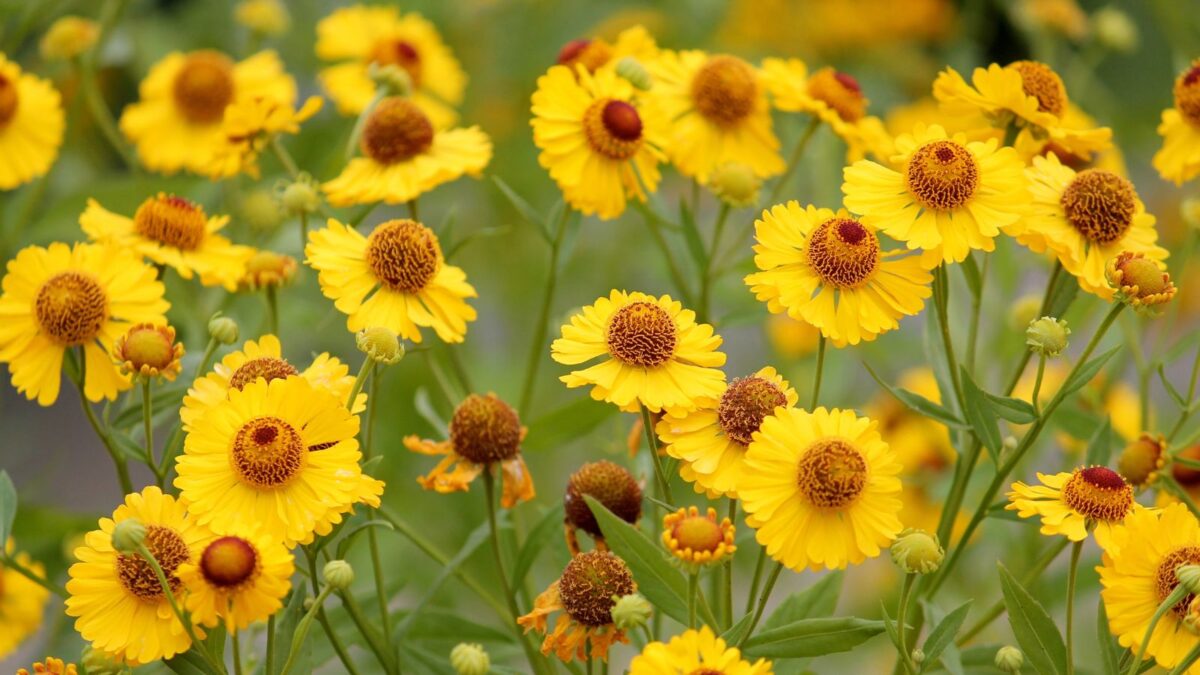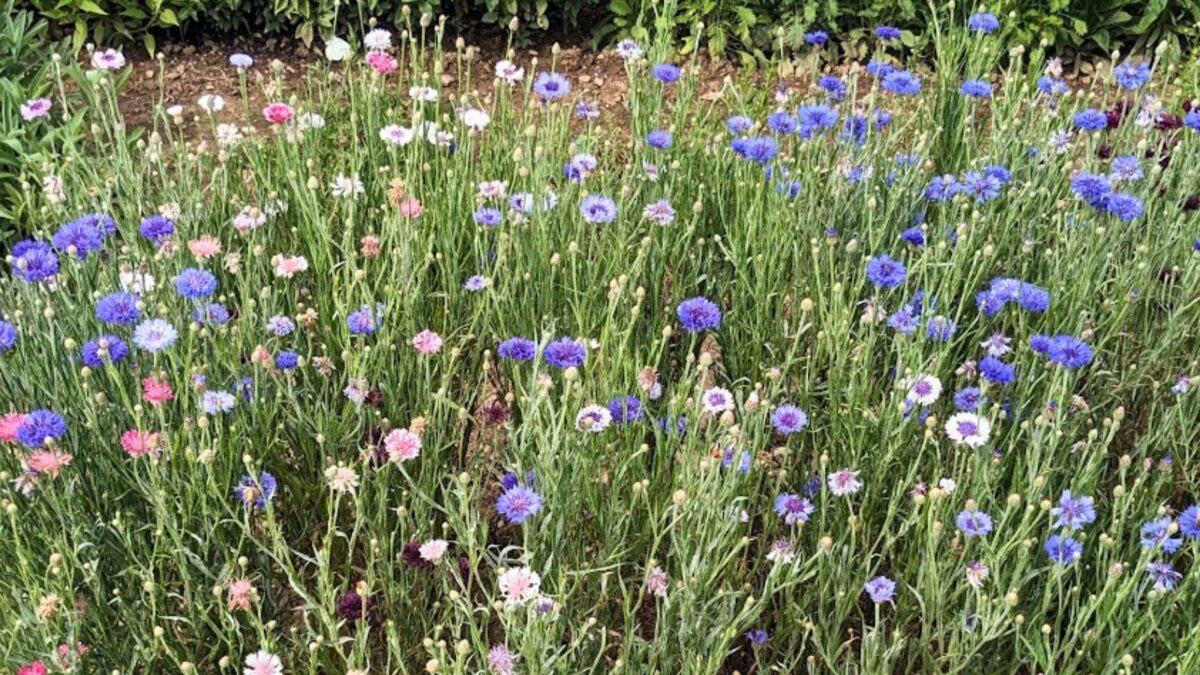One of the best ways to support bees and other pollinators is to plant bright flowers that provide good sources of pollen and nectar. While native perennials are always excellent choices, annual flowers that attract bees often bloom throughout the growing season, offering a steady source of food for the bees and beauty for the garden.
1. Salvia (Salvia spp.)

Annual salvias produce spikes of small, tubular flowers that attract many kinds of pollinators. Colors range from white to burgundy, and the plants average one to three feet tall and wide. Bumblebees seem especially attracted to ‘Summer Jewel Pink’ (S. coccinea) and ‘Purple Fairy Tale’ (S. verticilliata), the latter of which is also popular with honeybees.
These drought-tolerant plants like organically rich, well-drained soil in full sun to part shade. Many types will self-sow in ideal conditions.
2. Sunflower (Helianthus spp.)

Most sunflower species are native to the United States, making them an excellent choice for attracting native bees. The tall, cheery flowers bloom from summer until first frost, at which point birds replace the bees to enjoy the seeds. Favorites of bees include the dwarf ‘Music Box Mix’ and heirloom ‘Lemon Queen’ (both H. annuus).
True to their name, sunflowers grow best in full sun, though some will also tolerate partial shade. They also appreciate moist, well-drained soil. Any seeds overlooked by the birds may self-sow.
3. Butter daisy (Melampodium divaricatum)

From spring until frost, the golden yellow flowers of butter daisy bloom prolifically above a backdrop of bright green leaves. The plants have a mounding or clumping habit and grow one and a half to two feet tall and wide.
Wonderfully easy to please, butter daisy requires only full sun and good soil drainage. Once established, it rarely needs supplemental water and has very good drought tolerance.
4. Zinnia (Zinnia elegans)

The vibrant zinnia makes a wonderful addition to any garden, bringing bold color and attracting pollinators in droves. A good cut flower, it can also brighten up the inside of your house! Different cultivars range from just six inches tall to three feet, with the taller varieties perfect for growing along fence lines. Open, less ruffled flowers are easiest for bees to access.
Zinnias are among the easiest annuals to grow, needing just full sun and well-drained soil. For best results, also provide them with plenty of organic matter and good airflow.
5. Fern-leaf false foxglove (Aureolaria pedicularia)
The yellow, funnel-shaped flowers of fern-leaf false foxglove bloom in leafy racemes from late summer into fall. Bright green, ferny leaves provide a lovely textured backdrop. In addition to bees, the numerous blossoms also attract hummingbirds and butterflies. This native wildflower readily reseeds.
Fern-leaf false foxglove grows best in sandy loam or other occasionally dry, well-drained soil and full sun to part shade.
6. Cosmos (Cosmos spp.)

Cosmos provide abundant colorful blooms throughout the summer with minimal care. Their saucer-shaped flowers sway at the top of tall, slender stems and come in a range of vibrant hues, typically with a golden, buttonlike center. They have finely cut foliage and will grow one to six feet tall, depending on the variety.
These easy growers need only full sun and well-drained soil to be happy, and they tolerate drought.
7. Sneezeweed (Helenium amarum)

An upright, bushy wildflower, sneezeweed averages a foot high, sometimes reaching two feet, and blooms midsummer into fall. The golden petals of the daisy-like flowers droop down slightly from the darker yellow to brown, spherical center. Sneezeweed readily self-sows.
This US native tolerates drought and thrives in full sun and dry to medium soil with good drainage.
8. Bachelors buttons (Centaurea cyanus)

Also called cornflower, bachelors buttons grows one to three feet tall with showy fluffy flowers atop long stems. Though the most common color is an intense blue, shades of pink and white can also be found. Bachelors buttons make for beautiful, long-lasting cut flowers, and deadheading helps control spread, as they enthusiastically reseed.
An adaptable plant, bachelors buttons tolerates poor soil, drought, and light shade. However, it is happiest in full sun and moist but well-drained soil.
9. Purple gerardia (Agalinis purpurea)
Purple gerardia, or purple false foxglove, produces an abundance of pink to purple tubular flowers from late summer into fall. Native to North America, it works especially well in borders or clusters in naturalized areas, butterfly gardens, and woodland gardens. It reseeds to come back year after year, making it a good candidate for cottage gardens as well.
Happy in just about any well-drained soil, purple gerardia prefers full sun to light shade.
10. American bellflower (Campanula americana)
Another native wildflower, American bellflower can be found growing in moist, shaded areas of woodlands, meadows, and streambanks. Its racemes of flowers bloom throughout the summer, each blossom featuring five light blue to violet petals and a white throat. Bees and many other pollinators find them especially attractive.
American bellflower grows best in part shade and moist, rich soil with good drainage.
11. Jewelweed (Impatiens capensis, I. pallida)

Growing up to five feet tall with an erect to shrubby form, jewelweed is an impressively large woodland annual. It has attractive foliage forming a backdrop for its unique, cornucopia-shaped blossoms in yellow or orange, often with brownish spots. The mature seed pods pop open at the slightest touch, ejecting the seeds. It should be no surprise that this plant may spread.
Native to moist areas of North American woodlands, jewelweed likes rich, moist to occasionally wet soil in dappled sunlight to full shade.
Beekeeping For Beginners – Everything You Need To Know To Start Raising Bees

If you want bees in your yard, and veggie garden, you might want to add a beehive to your property. Here’s all you need to know about keeping bees.





